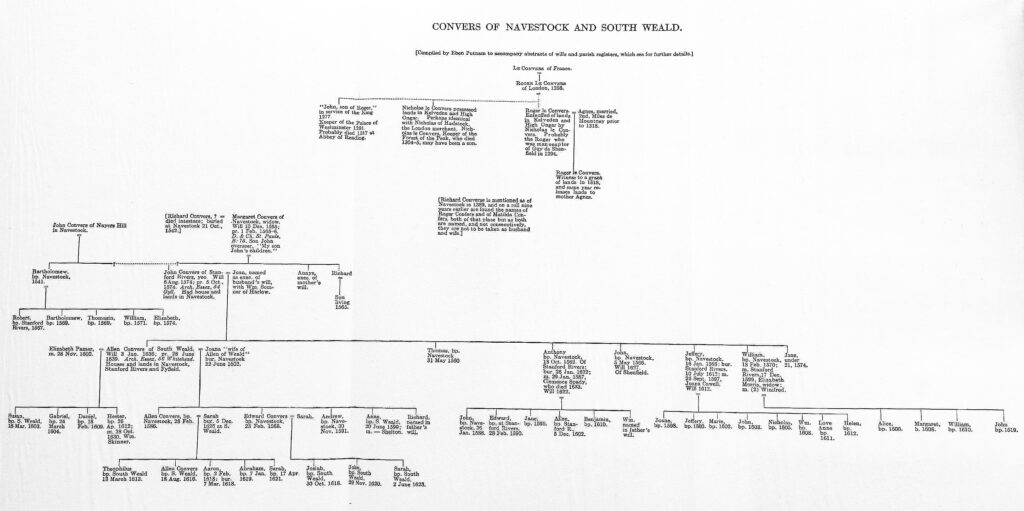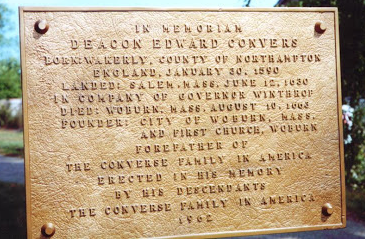Miscellaneous topics (under continual construction)…
Family histories are riddled with myths and legends, nice seductive stories that persist and evolve generation to generation despite the lack of any real evidence. For example…
1: Are we descended from a Norman knight, Roger de Coignieres (Roger Le Convers)?
This theory is very enticing but it has little basis in fact. It seems to have first emerged in a book by William G. Hill in 1887, but was totally debunked even as early as 1904 (see: Robert J. Kurtz, 1998).
It is true that there was a noble family in northern England named Conyers, possibly descended from this knight, but in order to show this family is related to us, you need to trace, with supporting documents, every single generation down to Deacon Edward Convers (1588-1663) who is the first person in the Converse family that we are really sure about. This cannot be done – the trail peters out before Edward, as has been explained by a number of researchers (see: Kurtz, 1998 and references therein).
Instead, there is good evidence for a number of people named Converse in the county of Essex, near London in the 16th -17th centuries. The best candidate for the Edward Converse who emigrated to America is the Edward Converse baptised in Navistock, Essex in 1588, since his children had the same ages and first names as those of the Deacon Edward in New England. See Hal Whitmore’s report for details.
* According to Wikipedia, Coignières is a commune in the Yvelines department in the Île-de-France region in north-central France.
Thus it is a myth that the Converses are descended from nobility or royalty. The Converses in Essex were yeomen, that is, they were working people. In New England, Edward Converse was referred to as ‘Goodman Converse’ in one document: he was not of the gentleman class. Interestingly, Kurtz points out that the “New England Historical and Genealogical Register, October, 1899, repudiates the descent claimed (by Hill 1887) for the immigrant Deacon Edward Convers, although in character and intelligence, he was the peer of the men supposed and claimed to have been his ancestors”.
Hal B. Whitmore (2015) has much more on this.
And you might also wish to take a look at: The Winthrop Fleet: Massachusetts Bay Company Immigrants to New England, 1629-1630 – Robert Charles Anderson (New England Historic Genealogical Society, 2012), p. 243
Although, as recently pointed out by Adam Rutherford, everyone is related to royalty…
“The last common ancestor of all people with longstanding European ancestries lived only 600 years ago, in 1400. This long lost ancestor appears on every family’s tree. If you hoped for a royal connection then you won’t be disappointed: as Rutherford explains, anyone alive today with a British ancestral lineage is almost certainly descended from Edward III, and all of his regal ancestors, including William the Conqueror…”
https://www.theguardian.com/books/2020/jan/30/how-to-argue-with-a-racist-adam-rutherford-review
“So the next time you hear someone claim to be descended from royalty, take heart: you are, too.” Scientific American – 5 October 2020
2: Was Deacon Edward Converse born in Wakerly?
Epitaph – First Burial Ground, Woburn, MA
“Born Wakerly, County of Northampton, England, January 30, 1590
Landed: Salem, Mass. June 12, 1630 In Company of Governor Winthrop
Died: Woburn, Mass. August 10, 1663
Founder: City of Woburn, Mass. and First Church, Woburn.
Forefather of The Converse Family in America. Erected in his memory by his descendants The Converse Family In America – 1962″
No – this is incorrect: most reliable records suggest he was born in Navestock, Essex (England) abt. 1588. Some sources quote his birthplace as Stanford Rivers, Essex – but that is only about 4 miles away from Navestock. Essex Archives Ref. D/P 148/1/1: Edward, son of Allen Convers, baptized Navestock, St Thomas the Apostle, 23 March 1588
3: More Q&A on Deacon Edward
We know quite a lot about Edward, the head of the first Converse family in America, but there are still some questions about his life in England as well as in New England. Read on here for a few possible answers…
4: “Convers” = “Conyers” ?
Some have suggested that the name “Convers” arose from a mis-reading/writing of “Conyers”, possibly by shortening the tail on the letter “y”, and seems to come from the book by R. Hill written in the late 19th century. However, it is now accepted in genealogical circles that the theory we are descended from the noble Conyers family is incorrect. Instead, it has been possible to trace our ancestors, called Convers (or sometimes Combers or Cumbers) back to the early 1500s.
5: Convers or Converse?
As we have discovered, the Converse surname derives from “le convers”, the name for Jews who converted to Christianity in 13th century England. At that time, French was the main language, as it was the language of William I (William the Conqueror). If Jews had converted, they were deprived of their assets, but offered accommodation in the Domus Conversorum in London.
In the 14th century, the main language reverted to English, with its Anglo-Saxon roots and newly acquired French words. People called le convers were now known by the designation “Convers”, although surnames were not really fixed at that time, so they might also be known by their place of birth (Licoricia of Winchester*), their father’s name (Anderson) or their occupation (Cooper).
There is also the problem that not many people were literate, and records were often written by scribes who were unsure how to spell (“mumble, mumble”) so Convers was written as Confers, Conbers, Cumbers, and so forth, and some of these spellings have superseded the original spelling, as seems to have happened in Essex, England, which has a group of Cumbers today.
Potential confusion may also arise from different styles of handwriting. An interesting example of this can be seen on the original will (from Essex Archives) of John Convers (1566-1627) on which his brother Allen Convers (1556-1639) is co-signatory…

When the first Convers/Converse people went to America, they still spelled their name without the terminal e, and I have found US gravestones from centuries later which still used the Convers spelling. Recently however, I received an email from a man in Texas who still does spell his name as Convers! This is not a recent reversion, his branch never changed their spelling. Interestingly, he is actually a distant cousin of mine, in my branch of the Convers(e) family from Upstate New York.
I then looked up “Convers” on Google and found several other people in the USA who spell their name this way, not just in Texas. I have not written to them or followed up their histories. Also, of course, there are French-derived Converses (I found one in California) whose ancestors seem to have arrived directly from France, not from England.
I should also point out that years ago a woman whose last name was Convis wrote to me to ask if I was the Carolyn Convis she had met at a Convis family reunion! I was not that person, of course, I have always spelled my surname Converse, as have most of us in the USA. This person claimed that Convis was derived from Converse, and indeed, I did find a graveyard on-line which contained a variety of stones for both Converses and Convises! Not proof positive, but it seems to me quite likely: if “Converse” could lead to Cumbers and other spellings in England, it might also lead to a variety of spellings in America?
I would be interested in any stories you may have about variants on “Convers(e)”.
Carolyn Converse-Cooper
*This is a very interesting historical book by Suzanne Bartlet, subtitled “Marriage, Motherhood and Murder in the Medieval Anglo-Jewish Community” edited for publication by Patricia Skinner and published by Valentine Mitchell in 2009.
6: Not the family tree
This is the (somewhat fanciful) family tree compiled by Eben Putnam (publisher)…

… as incorporated as an insert (p. 890, Vol. II) in some copies of The Converse Family and Allied Families by Charles Allen Converse. Click on the image for a larger picture, or click here for a PDF version. Note that significant links in this “tree” are missing and there is no evidence for “Le Convers of France”.
